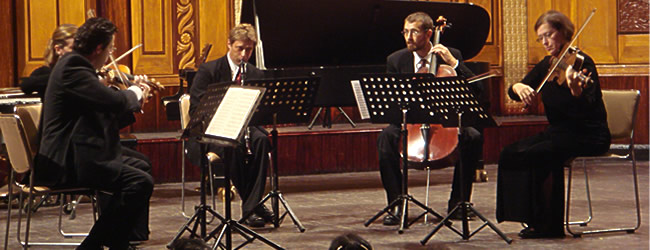Introduction
The historic
Vietnam-Cambodia Cultural Exchange Residencies that Southwest Chamber Music initiated in 2004 in Vietnam and Cambodia have finally come to fruition as Southwest Chamber Music celebrates its 20th Anniversary this year.
In December, Southwest Chamber Music, a two-time Grammy® Award-winning ensemble, was the first American ensemble to begin long-term residency and cultural exchange programs with the Royal University of Fine Arts in Phnom Penh, Cambodia, and the Hanoi National Conservatory of Music in Vietnam.
The two-week residencies in Cambodia and Vietnam initiated the first year of a three-year project. Subsequent seasons will bring music of Vietnamese and Cambodian composers to Southwest Chamber Music concerts and educational events in Southern California.
Southwest Chamber Music performed concerts and master classes at the Hanoi National Conservatory as part of their 50th anniversary celebration, and capped the trip with a
performance at the Hanoi Opera House on December 11th. Additional performances and master classes were held at the Chenla Theater in Phnom Penh, and a
special performance on December 5 as part of the World Culture Expo 2006, co-produced by Cambodia and South Korea.
Concerts featured the music of Cambodian-American, Grawemeyer Award-winning composer Chinary Ung. This is the first time Dr. Ung's music was brought home by an American group, with the first professional performances of his music in Cambodia. Dr. Ung, who grew up in Cambodia and is the most prestigious Southeast Asian composer, is the catalyst for Southwest Chamber Music's trip to Vietnam and Cambodia. His music and his presence represent the symbolic healing of the past and look forward to a future with peace and harmony. Concerts also included music of Mozart, Barber, Harrison, Cage, Takemitsu and Mendelssohn, and included side-by-side performances with Vietnamese musicians. A work by Vietnamese composer Phuc Linh was also performed by Southwest musicians in Hanoi. Southwest Chamber Music's players participated in master classes in both cities, providing an educational component to this historic trip, as the first American ensemble-in-residence in both countries since the Khmer Rouge era and Vietnam War.
Funding for the American portion of this project comes from a generous grant from the James Irvine Foundation. The overseas portion of the Cultural Exchange Project has been funded through the generosity of private donors. For more information, please visit Southwest Chamber Music or contact us at 1-800-726-7147.
*Pictures from left to right: 1. Composer Chinary Ung and Conductor Jeff von der Schmidt in Cambodia, 2004; 2. Executive Director Jan Karlin and Artistic Director and Conductor Jeff vonder Schmidt on an elephant ride in Cambodia, 2004; 3. Director of the Hanoi National Conservatory Thu Ha Tran and Conductor Jeff von der Schmidt in Hanoi, 2004.
Wednesday, November 29
“Walking through jello….” is how bassist Tom Peters described his journey through the mile-long airport mall in Singapore, in search of a meal and a massage (yes, both are available + rooms with showers & beds to be hired by the 6-hour block). Normally, Tom is a man with both feet firmly grounded, but there’s nothing like 23 hours of travel to erase any sense of reality - having been engulfed in darkness as we chased the sun’s shadow for 14 1/2 hours straight from LA to Taipei before our first plane change, and being served far too many breakfasts by stunning stewardesses, our minds anesthetized by (count’em) 80 different movies in at least 5 languages & nationalities instantly available on personal remote-controlled seat-back monitors. But if those feet need a helping hand, why not visit MY FOOT Reflexology while waiting for (gulp) another 3.5 hours until the next plane du jour, or a full body 30 minute massage (only $20, folks) as did Chinary & Susan Ung, and the aforementioned bass player.
Yes, wading through Jetlag Jello with (sorry, Mr. Frost) hours to go before we sleep, and yet another airline. The switch from Singapore Airlines to Silk Air meant not only new stewardess uniforms & nationalities, but actual aerial scenery: as we soared Northward towards Cambodia, those on the left side of the plane were treated to a magnificent towering cumulous sunset that would have made Max Parrish blush – why even those SoCal pollution oranges paled in comparison. Upon arriving in Phnom Penh soon after, the smell of woodsmoke in the Cambodian air solved the mystery of those amazing sherbet clouds, with the atmosphere so sweet & thick it must have had calories. What a delightful surprise to find a grand military welcome, complete with red carpet, flashing lights & bright white uniforms – but why are they facing the wrong way…? Oops! turns out they were there to greet the Sri Lankan Prime Minister.
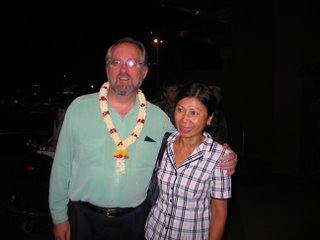
A shortish trip through immigration put us in the capable hands of Chinary’s sister Helen, and a semi-ancient tour bus which battled its way through 6pm drive-time traffic, deftly avoiding the countless scooters carrying anywhere from one to four (!) people. The final arrival at Hotel La Parranda on Mao Tse Toung Boulevard marked a personal best for most of us: the grand total? 35 hours of travel, door to door. Some headed straight for bed, some didn’t dare since it was only 8:15pm, and some (being musicians) headed for the bar at the 5-star fancy-schmantzy InterContinental across the street, only to find that the ‘local’ Tiger beer was a few notches below Coors.
But what fun to arrive in your hotel room after 35 grueling hours, only to find that there was no electricity in the rooms. WHAT? Turns out that just as one must slide a special key card into the door to enter most 21st century hotels, La Parranda has an intriguing doorkey slot into which you must slide the key fob – or else, no lights. The trick is, it’s inside the darkened room, and with no bell boy and no experience…suffice it to say that the 3rd floor hallway was filled with very tired, very confused American travelers. Sweet dreams!
On our way...
After three years of planning, Southwest Chamber Music left on Monday for our Cultural Exchange trip to Cambodia and Vietnam. Our group is 21 persons, including musicians, conductor, composer, spouses, and friends. In addition to our group, there is another group of eight Board members and donors who will travel alongside the musicians, enjoying the sites and attending our events.
Guitarist and KPFK radio host John Schneider will travel as our media correspondent, and will be posting to the blog once we arrive in Cambodia.
We are all meeting at Los Angeles International Airport on Monday evening to check in for our flight on Singapore Airlines. We stop briefly in Taipei, continue on to Singapore, and arrive in Phnom Penh, Cambodia, on Wednesday afternoon. The longest flight is 20 hours, and we won't count how many actual hours it will take us to fly from Los Angeles to Cambodia. Our check-in involves our instruments plus the extensive percussion instruments, in special cases, needed for the compositions by Chinary Ung.
We have been helped greatly by Global Spectrum, travel specialists for Southeast Asia. They have designed the special tour for the Board and Donor group, and also helped us arrange our airline tickets for the entire trip. Marcia and Susan at Global Spectrum have been invaluable, navigating our needs in loading all of the instruments and troubleshooting weight and size restrictions.
Helping us overseas are people in each city where we will be staying:
Amrita Performing Arts in Phnom Penh is presenting our concert on December 1st at the Chenla Theater, and arranging our Master Classes with students from the Royal University of Fine Arts. Fred Frumberg, director, and Rith, his assistant, have been our liason with the University, procured extra instruments needed, publicized the events, and taken care of our hotel and transportation arrangements.
The World Culture Expo in Siem Reap will present our concert at the Main Expo Site on December 3. We have communicated with many people at the Expo, and currently our contact is Suon Sovann. He has made all of the concert arrangements, provided for our hotel, meals and transportation, and will help us tour the Temples of Angkor on our free days after the concert.
And, traveling with us in Cambodia will be Chinary Ung's sister Helen Ung, who will make certain that everyone else does a good job on our behalf!
The Hanoi National Conservatory has so many people helping us that it is impossible to thank everyone here. Ms. Thu Nga Dan of Southwest Chamber Music has facilitated our Master Classes, rehearsals with the Vietnamese musicians, hotel, transportation, and concerts at the Conservatory and Hanoi Opera House. She has arrived early to meet with press and media, and finalize all of the arrangements.
All of the people described, and many more, above have helped make this trip possible, and we thank them!
The bags are packed with our concert clothes, the instruments are in hand, and it is time to go - Southwest goes Southeast!
Thursday, November 30
A hotel buffet with both European and Asian fare starts our first day in Phnom Penh. The brave ones broke their fast with chicken-rice soup & mystery meat mélange (with dandelion & other tasty greens), while others used the skills of the in-house omeleteer to whip something up right before our sleep-crusted eyes. Most reported a full eight hours of sleep, but a few bolted upright at 3 or 4am, ready to walk the dog, make the coffee, and head off to work – on another coast that was far, far away.
While some of the players took a morning On The Town, Chinary gave a presentation for the students of the Royal University of Fine Arts, focusing on his latest composition Rain of Tears that was premiered by the St. Paul Chamber Orchestra just last month. He spoke in Cambodian (which was then translated phrase by phrase into English by Sophy Him, a composer from RUFA – a strange experience, since we all know that Chinary speaks fluently in both languages), telling of the piece’s genesis. It was inspired by a prophetic dream that Chinary had just ten days before the infamous Christmas tsunami, but the composition also reflected the watery disaster that happened in America soon after. The senseless deaths caused by Hurricane Katrina joined the Asian tragedy to generate what has become the third panel of the trilogy which was begun by Oracle and Aura, the featured repertoire for this tour. He then played a concert recording of the new work, and it proved to be as powerful and awe inspiring as the events which precipitated it.
A Question & Answer session followed, which focused on the composer’s relationship with Western & Eastern music. Dr. Ung revealed that his basic philosophy has changed, and that his oft quoted aesthetic, “If the West is Blue and the East is Yellow, then my music is Green” has evolved. Now he feels that the two styles must coexist rather than blend completely. The resulting music should not be a ‘melting pot’, but instead, a ‘salad’ in which separate qualities can still be distinguished. One of the Southwest musicians wondered if the performers should be conversant in Asian styles to play his music, and the answer was that acquaintance and not mastery was enough to adequately perform the music.
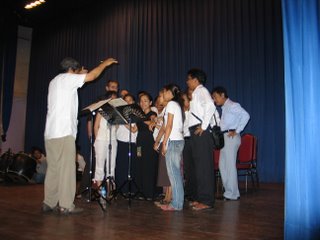
What followed was an extraordinary session where the RUFA students & faculty joined with Chinary to perform some of Cambodia’s most ancient and sacred music. The piece that was commissioned for Southwest Chamber Music by former Board President Sue Bienkowski and her husband Wang Chung Lee is Dr. Ung’s Aura, which deals with the Enlightenment of Buddha.
In this 45 minute work, Chinary has quoted from the ancient melody “Sathukar” which dates back to the Angkor period of Cambodian history almost a thousand years ago. It has long been embedded deep within the Royal court music, a complex weave of many related melodies whose warp and weft are rhythmically punctuated by drum & cymbal, but the composer has ‘excavated’ in from it’s original context and presented it in a very modern setting. In order to introduce the young Cambodian musicians to their ancient heritage, he planned to conduct them in singing the work, accompanied by the traditional pin peat ensemble of xylophones, gong circles, hand cymbals, a double headed drum and shawm-like reed instrument.
The irony was that Chinary had sent the music to the Royal University of Fine Arts several months ago, and the students were to have already learned it, so that the performance would take only a short rehearsal. But there had been a misunderstanding, and the musicians saw it for the very first time that very morning, just a few minutes before the scheduled performance. So Chinary literally taught it to them, both conducting and singing. The image was very powerful, and was the absolute essence of this historic tour: here was an internationally recognized American composer of Cambodian birth literally teaching his country its own past. And prophetically, using Cambodia’s past in his own modern music which points towards the future just as any living tradition should, even as the pin peat music of the past once did. The Cambodian students who performed the piece would hear it in its original form, and then hear it the following night re-embedded - but this time within an ensemble of Western instruments in a completely modern context.
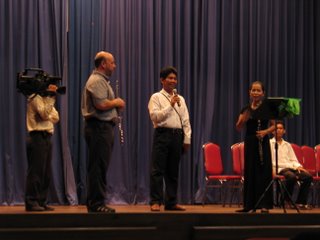
After lunch, another exchange took place: the same Cambodian students now performed Western music for Southwest’s players in a format known as the ‘Master Class’. Each local student had prepared an excerpt of a work from the standard Western repertoire and, after performing it, benefited from comments by the appropriate ‘Master’. The afternoon session began with RUFA’s flute professor playing Mozart and Poulenc, during which Larry Kaplan gave both musical and technical tips on how to improve the performance. The joy of a good Master Class is that one can actually hear the difference after the suggestions are applied, a most satisfying transformation for student, teacher and audience alike. After the Professor had her turn, a few of her students went through the same process, much to their delight.
The lucky student violinist who performed had not one but two teachers, and it was fascinating to watch how both Lorenz and Lisa approached their student from different but completely complimentary points of view. Peter Jacobson applied charm, logic, technique and philosophy to his cellist, with much appreciated and satisfying results. Sopranos Elissa & Kathleen were treated to a small chorus of singers who began by singing a traditional melody, but then a young tenor volunteered a Korean folk song, and then the famed Japanese song “Sakura”. This time, the tips were clearly visual as the teachers altered the singer’s posture, breathing and facial expression to enhance his sound. Basic techniques, but sadly, he had never had a proper lesson, as that art form is very new to Cambodia. One must remember that when Chinary Ung had been a clarinet at the very same Royal University some forty years earlier, he was playing the only clarinet in the entire country!
Friday, December 1
Friday: the morning is dedicated to the first rehearsals. 9am sharp: Mozart. Hey, where’s Peter? [Gotta have a cello…Inka! go wake him up!]. Getting to know the acoustically dry and atmospherically wet space, all went without a hitch – musically that is. Thu Nga lost her wallet (her room? The internet café? The sidewalk…?) Credit cards to be cancelled, cash to be mourned, and a thumb drive full of info that will be missed… But after rehearsal, lunch at “Friends” (thank you Lonely Planet) though some preferred the open air river view at the Foreign Correspondents Club, known locally as the “FCC” (a coincidence? hmm…I don’t think Howard Stern eats there). Then on to the Royal Palace, or the National History Museum.
To travel the roads is to taste & smell the grinding poverty of peripheral Phnom Penh. Street level shops seem to cluster in districts – one for shoes, a block of cellphone merchants, another for stone Buddha carvers & masons, above which the grimy darkened apartments wave us past with fluttering, tattered laundry. Daily life is lived on the sidewalks – cooking, cutting hair, teaching a baby to walk, changing bandages, all in plain view. A peek down any side street reveals unpaved roads, with garbage sometimes piled down the center of the passageway, swarming with humanity of every age. It may as well be Dickens, were it not for the umber fleshtones and tropical heat.
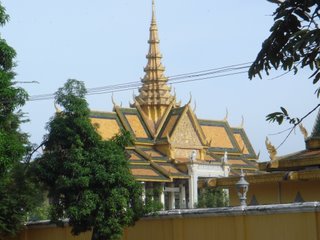
To arrive at the Royal Palace is a bit like finding Disneyland in the middle of Tijuana. The contrasting opulence, with manicured pagoda-dotted lawns between pristine empty avenues & wide low buildings with fantastic flamelike roof adornments arching into the sky, is a stark reminder of the class differences in this re-emergent society. The acrid cooking smoke that drifts through the palace gates from the homeless encampment across the street casts a melancholy pall, a constant reminder that the power and the glory of any empire is born of human suffering. Beggars and amputees hover around the Palace entrance, while wide-eyed children with emaciated bodies plead with chilled water bottles in hand…
Once the Italian marble stairs have been climbed, hats and shoes removed and shoulders covered, the Silver Pagoda slowly reveals its treasures as the eyes become accustomed to the low light. It soon becomes apparent that this is indeed one of the most extraordinary rooms in the world. Southern Italy may indeed boast of a chapel floor completely covered with exquisite marble portraits of the dignitaries that are buried beneath, but imagine a floor that is entirely paved with 5000 solid silver tiles! Of course the visitors traverse this extraordinary surface treading protective Persian carpets, but enough of the shining surface is visible to take the breath away. And then the eyes raise up to see in the distance an accumulation of precious mineral & metal that is simply jaw dropping. A towering golden pyramidal structure is topped with a two foot seated Buddha carved from solid Emerald (though some guide books insist that it is Baccarat Crystal). In front this amazing dais is a life sized golden Buddha, encrusted with over 9,000 diamonds.
If this were the Metropolitan Museum or the Louvre, there would be armed guards at every corner, and two-inch plexiglass encasing each fantastic sculpture. But here, two skinny middle-aged attendants at either end of the room only occasionally glance up from their reading, usually to check their watches. The glittering Buddha gazes from a vertical sarcophagus made of 1/4” plastic, a simple box whose security is entrusted to a tiny luggage lock.
Cultural cognitive dissonance greets the visitors to the Throne Hall, once the eyes acclimatize to the glare of gold and white. The typical trappings of majesty are displayed in this overwrought display of pomp and circumstance. The culture clash becomes immediately apparent when viewing the high frescoed ceiling which is clearly inspired by countless European palaces. The form & structure is reminiscent of Versailles, but instead of the expected rosy bottomed cherubs, this ceiling is populated with the stylized dragons and demigods of Southeast Asia (you were expecting, maybe, Zeus?). Predictable, but unusual none the less.
Returning to our hotel through the center of town, it becomes immediately clear that Phnom Penh is booming, its renaissance made apparent by an extraordinary number of building sites. The ‘American’ war had ended just a few years before the horrors of the Khmer Rouge destroyed society, and it is gratifying to see such an exuberant response. This is one of the reasons that we are here, to participate in a cultural rebuilding that complements the regeneration of infrastructure.
Finally! the moment has arrived. After three years of careful planning, intercontinental phone calls and emails, incessant fundraising, travel documents, travel agents, hotels, airlines, etc., and after a morning of rehearsals, frantic running around town via tuk tuk (the ubiquitous motor scooter drawn richshaw/taxis) in search of a vibraphone and a drumset, the Chenla Theatre of the Amrita Performing Arts Center was ready for the Cambodian premiere of their native son’s Aura, preceded by two works of Mozart.
Lots of unknowns, too: how would the Cambodian audience react? Without a tradition of Classical concert going, would there be any problems? As it turned out, there were definitely some unusual activities during the concert. As the musicians filed out on stage for the opening Mozart Flute Quartet, an announcement came over the loudspeakers directing in two languages that all cellphones should be turned off, and that there should be no flash photography. But after the first thirty seconds of music, a young man with digital camera at the ready jumped up and headed right to the edge of the stage, and begins to frame his photograph. After trying a few initial angles, he finally settled on a vantage point, and took the shot (with no flash, thankfully), sauntering back to his seat while reviewing the results. Ten seconds later, a TV camera on a tripod switched on its Klieg lights (nobody said anything about floodlights, did they?) and calmly begins filming the audience reaction…for about three minutes. And did I mention that the air conditioning was never turned off? Not inconsequential, since the delicate ensemble of strings and flute were never designed to compete with 60Hz hum and the rushing of chilled air! The players later reported that they were playing at capacity to battle the dry acoustics and machine noise, but the results were marvelous.
Predictably, there was applause after each movement, but unpredictably, flutist Larry Kaplan was given a bouquet after the Flute Quartet! Jim Foschia’s beautiful solo artistry in the Mozart Clarinet Quintet which followed was greeted with warm and deeply appreciative applause (but no flowers).
Had this been a concert given in any city with a history of Classical Music performance, there would have been an intermission at this point in the program. But the Southwesters decided to carry straight on and, after brief introductory remarks given by Jeff von der Schmidt (ably translated by the Cambodian composer Dr. Him Sophy), the entire group assembled on stage and preceded to present a powerful performance of Aura. With the exception of a few talking children (and the audience was filled with young people), the crowd was spellbound for the full forty-five minutes. The local musicians surely recognized elements of Cambodian traditional music in the complex score, but the music is not easy listening by any standard, and the rapt attention and enthusiastic reaction of the audience proved that the evening was a great success.
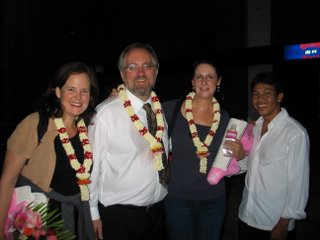
At its end, Aura was greeted with loud applause, bouquets for the soprani, and one for the much appreciated composer – which he deflected and graciously offered to the conductor. In fact, before the applause had even begun to wane, one fan ran to the edge of the stage and requested an autograph from one of the singers. In a moment, the audience streamed onto the stage, bestowing every performer with a gorgeous thick rope lei woven from jasmine blossoms, each terminating in a pendant of exotic local blooms. It was an evening that will surely be remembered by Phnom Penh for years to come, and an auspicious beginning to what will surely be a historic cultural exchange.
Saturday, December 2
Travel Day! Up early, pack and eat, and off we go at 9am sharp. Spirits are high, and the much newer tour bus is redolent with last night’s jasmine leis, some worn on the neck, some bejeweling instrument cases, others in the luggage rack above our heads spreading their olfactory cheer.
The trip out of town is as fast as the incessant traffic will allow, as we pass the Olympic sized stadium, delightful painted statues (a sea goddess wringing her hair, one foot on a crocodile, and later a life-sized elephant being taken down by two attacking tigers), the medical school, dozens of temples and more new construction.
The ride northward to Siem Reap could take anywhere from three to six hours, as no one seems to know for sure (even the ubiquitous Helen who actually lives there and travels to Phnom Penh monthly), so an informal pool immediately begins. Are we talking exact prediction? Closest above, or below the actual time? The gamblers negotiate lightly, as it’s clearly a game of entertainment rather than a true Game of Chance. It becomes clear as we pass traffic in both directions that Americans are incredibly wasteful. Not that this is news, but we’ve been missing a lot of opportunities. Who knew that a little Honda scooter could carry four people? Certainly not the State of California Motor Vehicle Code. Sure, there is such a thing as a Bicycle Built For Two, but why stop at two? Most vehicles carry at least double the number of passengers for which they are designed, plus building supplies, or baskets, or…And who knew that the best seat on any minivan isn’t inside at all, but on the roof – with the more the merrier (seatbelts not included). I know, our children have been telling us that for years [pleeeeeez Mom?] – wisdom from the mouths of babes. Turns out that those same scooters that dart in and out of traffic can also ride on top of vans, sometimes two abreast facing forward, though I saw one van with 4 scooters perched sideways atop a van with so many heads inside I couldn’t count them. And the further one gets into the countryside, the more inventive both the vehicles and their contents become.
Ah, the countryside…we actually traversed about 2/3 of the entire country in one day, and watching the plants, animals and water content of our surroundings change by the hour was a source of constant fascination. Remembering that the Tonle Sap river reverses yearly, flooding the plane and easily doubling or tripling the size of Tonle Sap Lake, it makes perfect sense that most of the structures we pass are on stilts. When the Big Bad Wolf monsoon season comes, it huffs, and it puffs, and blows and blows…and all three little piggies live here: some in houses of straw, some of wood, and some of brick, all on stilts. The amazing thing is that all three types of structures are still standing, in various states of repair. Since the road we travel is the main highway, all housing seems to cling to its slow curves, so we could sample every level of human existence from 3 story chalets with satellite dishes to thatched huts with the floor space of a California King sized bed. The chickens live underneath. When not tied to the house stilts or wandering around the fields, the domestic water buffalo seem to hang out in the front yard, usually in a 10’ x 10’ pool of water that looked like a shallow private rice paddy, until you realize that the black humps moving around in the middle are actually bovine, making them at least 4’ deep.
One strip of road besides the water was lined with stalls selling dried fish, the wares hanging in symmetrical flat, tan fan-shaped clusters. Halfway through the morning, we pulled over at a rest stop that had an open-air restaurant, bathrooms, and dozens of food stands with delectables both recognizable and not. As always, vendors plied their wares by insistently bringing them to face level, assuring in monotone memorized phrases that the contents were the best. The real hit of the smorgasbord was an item that Chinary had been joking about for at least an hour before we arrived: fried insects. Dares and double dares were traded before our arrival, since most imagined crispy ants or grasshopper tempura – no one was prepared for the plates piled high with greasy, black deep-fried tarantulas. Yes, you read that right – tarantulas, and not those dark brown hairy desert types, either. These puppies were black, bald, and Ugly. There were quite a few busloads already pulled up, and one fella was actually playing with a live one, letting it crawl over his hands, while his girlfriend fed him the fried version, one at a time. In case you are wondering, the answer is “No”, no one from our bus sampled the arachnid appetizer, but we did wolf down some sweet rice sticks cooked in banana leaves, and lotus seeds.
More miles, more raucous repartée – Southwest Chamber Music may well be a Grammy Award Winning chamber ensemble, but most of the players could easily hold their own at Open Mic night at the Comedy Club. They are not only fleet of finger, but swift of mind as well: just imagine the best dinner party banter ever, but for hours on end, and you will start to get the picture (and it turns out that our distinguished composer-in-residence, the formidable Dr. Ung is perhaps the funniest of all!).
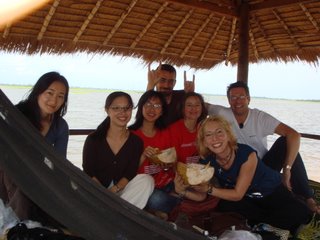
At lunch, we pull of the road next to a lake, and pile out of the air conditioned bus to enjoy a picnic prepared by the magnificent Helen. Picnic tables with checkered table cloths? Not even close. We climb up five or six rough, wooden ladder slats into open sided thatched platforms on stilts to enjoy our sandwiches, cake, and delightfully nutty tasting miniature bananas. To wash it all down, a young woman brings over a cluster of green coconuts and, one by one, expertly hacks off the thick husk to reveal a spongy membrane which was then pierced with a straw. Voila! Coconut milk that was clear, slightly tangy, and not at all sweet like the Polynesian versions found in SoCal grocery stores. Once the liquid is finished, the husk is split in two to reveal a thin 1/4” layer of gelatinous ‘meat’ that is so soft, it can (and was) scraped off with a piece of husk as a spoon, and gobbled for dessert.
Back on the bus, we continue past infinite variations of stilted houses, personal livestock and rice fields, our driver with one hand on the steering wheel and the other on the horn. The staccato beeping, an essential component of Cambodian driving style, was incredibly loud inside the bus, but even that became tolerable, almost imperceptible after a few hours, like a car alarm that the mind decides to ignore. Some even dozed off, until a particularly urgent series of blasts and a sudden slamming of bus brakes brought everyone bolt upright, ready for the oxygen masks to pop down from the ceiling. It seems that the overpiled truck directly in front of us had just lost a large cardboard box which toppled out of the back and split open directly in our path. Some said it contained a small refrigerator, others weren’t sure, but a deft swerve and ample brakage saved the day. Rousing applause for our intrepid busman!
Another roadside attraction was always our fellow travelers, as the variety of vehicles on the road is absolutely astonishing, surpassed only by the quality and quantity of their contents. I’m sorry to report that The Three Little Pigs have finally met their demise. In spite of their best efforts in straw, wood and brick, we saw them carted off to market – all three on the back of a single scooter. But isn’t over ‘til it’s over: though tightly ensconsed in boards & salad greens, some report that the hooves were still twitching, so there still may be a chance for escape!
Entering Siem Reap reversed the process we had experienced leaving Phnom Penh: farms gave way to businesses, houses grew closer together, the livestock disappeared, and the accretion of urban lifestyle (advertisements, scooter showrooms, hotels, etc) finally trumped countryside. Billboards appeared, touting Angkor Wat and the wonderful temples that we would soon be experiencing, and luckily the road was far away from these national treasures.
If Phnom Penh seemed to be booming, Siem Reap is positively exploding with new construction. Past the city center are literally dozens of brand new six or seven story hotels along the single two-lane highway, and many more still in their infancy. A bit like the scores of restaurants, motels of varying quality that ring Disneyland, these establishments are here for one reason only: to service the hundreds of tour buses from all over Asia that come to experience the wonder and mystery of Khmer Culture.
Once we actually found our hotel (making U-turns with a huge touring bus on a crowded outmoded 2-lane highway is no mean feat – we did it twice), room keys were handed out, and the all important Photo ID Pass that was to let us into all World Expo events, the temples and also our meal ticket (worn around the neck on a lanyard, like a backstage pass).
The ‘Tonle Mekong’ restaurant was to become our lunching and dining habitat, just two doors down from the Hotel. And what a habitat it was on that first night as we crossed the gravel parking lot with a dozen or so diesel tour buses parked out front. Walking in, the sight was numbing: dozens of 20 foot long tables with hundreds of people eating away, others speeding back and forth between the glassed off buffet rooms beyond, and all eyes and ears focused on a raucous floor show. Brightly stage lit and highly amplified, seven or eight couples in ‘native’ dress were dancing away and shouting some folk-type melodies to the accompaniment of a pin peat ensemble, the very same mallet, percussion and reed instrumentation that we had heard played by the Royal University of Fine Arts students a few days before.
But this was clearly music for the masses – what someone aptly characterized as a ‘hula’ show where profound cultural assets had been trivialized for the tourists. In fact Chinary, the very man who has returned to Cambodia to help reacquaint the country with it’s ancient classical Khmer heritage, chose to eat in the farthest glass enclosed dining room, and turned his back on the floor show. The man is a realist, of course, and understands the relationship of commerce to the revitalization of the Cambodian economy, but that doesn’t mean he has to have it ruin his dinner.
Sunday, December 3
Up an hour earlier today and out the door at 8am to make it to the elephant ride. We take a different route than yesterday and pass some palatial old-style hotels, more construction, and the Children’s Hospital, home of the famed Beatocello. Seems that the resident Swiss doctor Beat Richner is also an amateur cellist, and every Saturday night at 7:30, he plays the Bach Cello Suites to raise money for the hospital. So out in front of the institution are huge signs, and posters with closeup photos of a cello and an infirm infant. The concerts are evidently a great success: how wonderful – another meeting of East and West as Bach helps save the children of Cambodia from dengue fever and other common blights.
Speaking of health, one down and none to go (if we’re lucky!). Lisa the violinist is the first and hopefully last to succumb to some sort of food poisoning. About fifteen minutes after dinner, things just didn’t seem right, and they weren’t. A rough night followed by a day of sleep got her on stage by the afternoon soundcheck, but just barely.
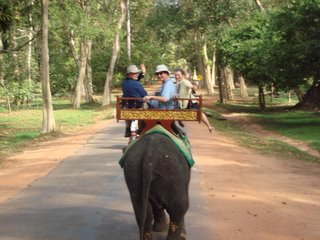
Entering the walled city of the thousand year old Khmer Empire was truly awe-inspiring. The walls have also kept out modernity – though in reality, the jungle did a pretty good job of that until the French stumbled upon the wildly overgrown ruins in the mid 19th century, and folks have been digging & pruning ever since. The sheer magnitude of the structures, let alone their exquisite design and function, is simply mind boggling. Our trip planners have wisely introduced us to these Wonders of the World in an order that ranks Least to Best preserved, so that by the time we arrive at Cambodia’s Crown Jewel tomorrow, Angkor Wat will fill in all the blanks that centuries of looting and dilapidation have robbed from so many other sites.
Climbing onto our elephants, we approach the gate that protects Angkor Thom three at a time, swaying and plodding at a medieval pace while awkwardly turning backwards to try to photograph the next trio. After all, no one is really going to believe that you rode an elephant in Cambodia unless you have proof, right? The pachydermal pace does help erase the 21st century left behind us,, though we are still passed on the road by the mosquito- like buzzing of everpresent scooters. It is hard to imagine that these walls held over a million people a thousand years ago, and that the arts, culture, astronomy and architecture far outstripped anything found in Europe at the time.
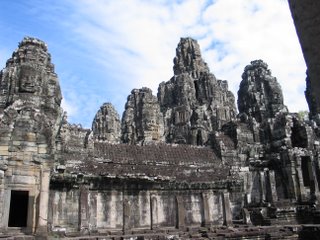
Upon alighting, we turn to see the 54 towers of Bayon, each of which is crowned with four giant faces of the Avalokiteshvara (the god of compassion) facing in the cardinal directions. The sandstone faces turn out to be Jayavarman VII himself, the king who constructed this amazing temple in the exact center of Angkor Thom. Images of Indiana Jones or Tomb Raider immediately spring to mind as we climb the grand ruined entrance and enter the temple which is ringed by elaborate bas-relief carvings that tell of daily life in what was once a teeming metropolis. Deep within, Buddhist shrines glow with candlelight and burning incense, each attended by a supplicant who hands you 3 glowing sticks, eager to show you how to bow to the statue which is adorned with saffron robes. Except for the shuffling of tourist feet, and they are legion, you may well be in another century, for at this moment, time has stopped.
After an hour of exploration and actual wall climbing (how long are they going to let us do that!?! Stonehenge is now fenced off, and for good reason), we meet the bus in front of a few souvenir stalls. A tro (Cambodian 2-string fiddle) catches my eye, and I turn to Susan Ung for advice. She may be one of our two Western violists, but she is also a master of these Asian bowed instruments, having played them professionally for years. The vendor hands Susan the instrument, trying to show her how to hold it, but soon backs away amazed as beautiful music begins to pour out of its tiny soup can sized body. A crowd quickly gathers, the locals astonished that a “tourist” knows their fiddles so well. Chinary gives the nod to this particular instrument, deemed of very high quality, and a few minutes of haggling puts it in my hands for keeps. (Now how the hell do I get it home?) But the music isn’t over: a few hand drums hang nearby, and Lynn Vartan and Chinary do a little improvisation to the consternation of all. Never a dull moment with C.U. around!
The Terrace of Elephants is next, a huge reviewing stand that faces the large now empty parade grounds, carved with parading elephants along with some garudas. The scale of the place outstrips Washington DC by a mile, especially when you remember the century of its use…
But too soon we are back on the bus and returning to Siem Reap [which means “Siam Flattened” by the way…a constant reminder of the Thai’s intimate relationship with Angkor through the ages and even recently] to lunch, nap, and prepare for the World Expo.
If you have ever attended a World’s Fair, those international booster events that used to get thrown every four or so years, you can easily imagine the format of the Angkor-Gyeongju World Culture Expo 2006. South Korea, Asia’s other capitalist wunderkind, pairs up with a different country on a regular basis to heighten mutual awareness and develop both business and consumer ties. For the first time ever, Cambodia is being featured – a huge development for this nation that has known profound suffering until very recently (the American War, Pol Pot) and is struggling mightily to rejoin the family of nations. A third of Cambodia’s population now live below the U.N. poverty limit, while the Danish Red Cross reports that in Cambodia and surrounding countries, somewhere between 250,000 and 400,000 women are sold every year for prostitution and forced labor because the society has not been able to find a place for them. At present, tourism is Cambodia’s best hope for economic revival, and Koreans will send at least 300,000 this year.
Enter the World Expo.
To celebrate the 10th anniversary of the establishment of diplomatic relations between Cambodia & South Korea, each country has provided Culture Pavilions, food booths, shops, Folk Game Courts, and concerts for fifty days of celebration. There is even a 3D film theatre featuring special dramatizations of each country’s mythical origins. All in all, twenty-eight countries are participating in this Expo, and Southwest Chamber Music is the only American ensemble performing at this historic event, made all the more special because of their performance of Chinary Ung’s music.
The concert is scheduled as the evening’s main event, and the large outdoor covered stage is covered with microphones so not a moment would be missed. After a meticulous 4p.m. sound check, all is ready to go, so many of the players cruise the Expo grounds until showtime. During the scant two hours that precede our concert, an amazing array of performances are available on the smaller outdoor stages that are scattered around the fairground. Stage #2 offered a Chinese Cheng quartet (that country’s version of the koto), with the young women beautifully coifed and dressed, their singing and plucking accompanied by a traditional court drum. Simultaneously on a stage a few hundred feet away was a troop of Korean dancers, exuberant with their hand held drums & cymbals, not to mention the twirling banners attached to their hats and their lithe acrobatics. Near that was a trio of Mung musicians playing folk music on amplified tube zither, tro and voice. And for the kiddies, a carnival complete with ferris wheel and games. All amplified, and all going at the same time.
Remember that.
7pm rolls around and, as if on cue, the full moon slowly rises above the Grand Stage, as Hollywood style movie searchlights sweep the sky (and there’s even a full-blown Angkor Wat backdrop behind the band!). The hundreds of seats are filled with wide-eyed visitors both local and foreign, and the four plush leather armchairs that are set directly in front of the Grand Stage are finally occupied by government dignitaries which include the Kingdom of Cambodia’s Secretary of State and the Vice Chairman of the Expo. There are ceremonial welcomes, a few short speeches appropriate to the magnitude of the occasion, and the show begins.
The Mozart Flute Quartet in D-major opens the program, beautifully played of course, but it becomes immediately clear that something is a bit ‘off’. All of the other events are still going full tilt, with their concomitant hubbub cheerfully joining in with the elegant chamber music. Undaunted, the players carry on, and luckily, so does the audience, entranced by every note. The Mozart Clarinet Quintet follows, with no change in ambience, as the amplification carries every note to its intended destination.
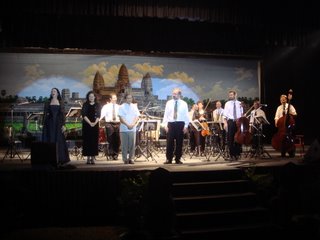
Then the piece de resistance, Chinary Ung’s Aura. After a few quick remarks from the Master of Ceremonies, the composer and the conductor, the magic begins. And so does an outdoor film a few hundred feet away! But Southwest prevails, and all else simply evaporates from the audience’s consciousness. The performance was, to my ears, one of the most spirited and inspirational to date. In spite of the heat, the wind, and the extravagant menagerie of insect life that seemed to be drawn almost magnetically to the sheet music (some of the players actually sprayed Deet on their seats and stands), the power of the score was inescapable. Forty five minutes later, the crowd stood in deep appreciation, as the dignitaries went on stage to shake hands with Chinary & Jeff, bestowing each with large bouquets, and the soprani with flowers and gifts. The television interviews that followed were broadcast the following day on National TV.
Both exhilarated and exhausted by the challenges of the evening, the players headed off to a marvelous dinner hosted by our gracious donors who are traveling with us, Ellen and Harvey Knell, Sue Bienkowski and Wang Chung Lee (who are also joined by the rest of the donor group of Patsy Neu and Ken Garen). The evening finishes with the revelation that Chinary not only an exquisite composer, but a master at table entertainment. If you are ever lucky enough to be sitting next to him at dinner, simply hand him two forks, two toothpicks and a water glass, and get ready for a delightful surprise. And if you ever wondered how to retrieve (with one finger only, now!) a dollar bill from under a pile of quarters while it balances on top of a bottle…
Monday, December 4
Another day of templing begins with puffy eyed breakfasters coming down in shifts. Larry & Jim got the jump on everyone and have tuk tuked (yes, it’s a verb here) to the temples hours ahead of us to take advantage of the cool morning air before it returns to it’s usual inescapable blanket of heat and damp. An auspicious beginning: today is Thu Nga’s birthday (no numbers please, but it ends with a ‘0’, which means BIG), so the whole group waited at the elevator, and when she stepped into the lobby, a rousing version of “Happy Birthday” led by yours truly on my brand new Cambodian tro (a string instrument), lit her up like a Christmas tree. And yes, dear readers, unlike any such greeting that you have endured, it was in tune – in glorious four part harmony. Then off to Ta Prohm and Preah Khan.
MegaWat...
So how was Angkor Wat? Two words: SIZE MATTERS. This most famous of Khmer temples is stupendously impressive. It’s hard to stem the flow of superlatives when describing this marvel: the surrounding moat separates the first surrounding fortification from the impending jungle with a football field’s worth of water, so wide that it seems to have it’s own ecosystem. The lone bridge which spans it is wide enough for a parade, which it certainly gets on a daily basis as hundreds of tourists per minute traverse its worn stones. The first magnificent gate impresses with tall arches, hiding incense breathing Buddhist shrines and vanishing views to left and right through the long, shadowy arcades. It takes twenty paces to arrive at the other side of the wall, but that 21st step reveals an immense enclosure, breathtaking in scope, with the renowned 5 towers at its center – very, very far away.
It takes about 5 minutes of walking to arrive at the temple itself, past the two gorgeous libraries on either side of the path, resembling little Angkor Pantheons, and a large outdoor stage being constructed for more Expo concerts later in the month. Up the steps, and the main event begins. With walls within walls, gate after intricately ornamented gate, and level upon level, the complexity of the central temple structure has been studied for generations, each pass revealing more & more about the astronomical, cardinal, mathematical and spiritual parameters of the millennium old nexus of Khmer culture. Where to start? The exterior galleries which surround the entire temple complex are famously carved with Ramayana monkey battles, The Hindu “Churning of the Sea of Milk” creation myth, Heaven & Hell and so much more that a small library has been written on the subject.
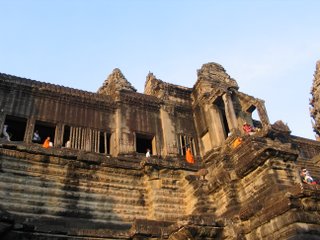
To enter the inner sanctuary, one slowly ascends through the Hall of a Thousand Buddhas (only a few now, but probably once…), past vast symmetrical pools which must have been stunning when filled. Penetrating the next ring of surrounding galleries reveals the heart of the structure – the central temple with its five famous towers, one on each corner surrounding a central ‘spire’. One can climb to the summit, but must negotiate 30 feet of Aztec like steps that are only 4” deep but 12” high, making the irresistible ascent incredibly dangerous (one unfortunate climber was seen leaving the premises nursing a badly torn & bloody knee on borrowed crutches). One such stairway does actually have a slender handrail, a lifeline for the scores of view seekers that reach the pinnacle probably not knowing that there was only one ‘safe’ exit (yes, the line to descend was very long, very slow, and very hot), but joys to behold from above were worth every effort. Then again, if you wanted a really transcendent view, as did Larry & Jim, go up in the hot air balloon tethered just outside the moat.
Angkor Wat is worth at least a week of visits, but we have only three hours. Luckily they were the last three hours of the day, and we were able to experience the legendary sunset that bathed the compound in the magical golden light that has launched a thousand postcards. Experiencing the profound calm of this, one of the world’s most famous ‘power spots’, can last a lifetime, or at least as long as it takes to get back across the moat and be swallowed up by the swirls of noise, diesel exhaust and unrelenting street urchins hawking anything from guide books to silk scarves & miniature Buddhas.
For those tired of the throngs at Tonle Mekong, a delightful French/Cambodian restaurant called Madame Butterfly finished the evening with exquisite local fare which included curried fish, mango & chili salads, various soups & vegetables, and wonderful desserts.
Tuesday, December 5
The last temple of the Cambodian part of the tour is 90 minutes away from the hotel, and we’re talking country roads here: not dirt & potholes, but very uneven surfaces, plenty of dust and enough bone jarring bouncing for the most avid bronco buster.
Banteay Srei Temple almost seems like a miniature temple, as it was peopled almost exclusively by Buddhist nuns, and the doorways rarely exceed 5’ in height. It is said that only the delicate hands of women would be capable of carving the amazing details found on most lintels, including one memorable ‘reflection’ scene in which sun appears to be eating the moon (an eclipse?). The color and quality of the sandstone in this part of the empire also sets this temple apart from the others, with its deep red hues familiar to visitors to the Grand Canyon, but with finer grit, hence amazing ability to hold artistic detail.
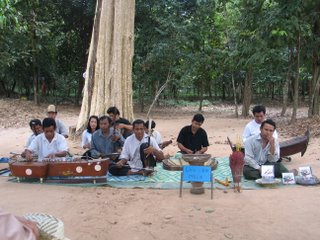
Another extraordinary treat is the music which bathes the site. What sounds at a distance like a traditional Khmer wedding band is anything but, for rounding the corner, one sees a shocking ensemble of misshapen bodies, dutifully bowing, plucking and banging their instruments at unexpected angles since most are missing limbs, eyes, or both. A hand drawn sign informs us that these are the Land Mine Musicians, whose playing is as joyful and expert as you would ever want to hear, but their heartbreaking circumstances are a visceral reminder that ancient scenes of death and destruction that decorate the temples of centuries past is still very much a part of the Cambodian present. One player deftly balances his instrument on the stump of one arm as he simultaneously holds and fingers the tiny flute with his remaining hand. Another, who smilingly sells the group’s homemade CD between numbers, also holds his instrument in his one remaining hand, a wide green leaf with a single fold placed on the inside of the lower lip, and exuding a beguiling wail that soars above even the two bowed tros, hammered dulcimer, trough marimba and mandolin that accompany him.
Once back in the bouncy bus, our long ride home is punctuated by a visit to a roadside manufacturer and vendor of palm sugar candy. In front of most stilted houses along this road, one sees identically shaped silver metal cauldrons boiling atop earthen ovens. The liquid is juice collected nightly in foot-long bamboo tubes from the sugar palms that grow throughout the areas. Each morning, the nocturnal harvest is boiled down to a tasty blonde paste that resembles maple candy but tastes like buttered sugar cane when cooled and wrapped in folded banana leaves. Quite a few of us leave the roadside stand with sticky fingers, sweetened tongues, and a few more goodies to pack.
And pack we must, for tonight we head to the brand new airport at Siem Reap on the next leg of our journey to North Vietnam. But not before spending a few expensive hours wandering through the Old Market in search of last minute bargains, this being December season of giving, and the prices will never be better. How did a dirt cheap high-end North Face back pack end up in a dingy stall next to pig snouts and dried fish? Are these knock-offs? Not on your life: where do you think most of the Famous American label manufactured items that fill our shelves and closets are actually made? Read any of your labels lately? Chances are that a hefty percentage of everything you use, wear or buy was made within 200 miles of where we stand.
Hundreds of stalls offer gorgeous Cambodian silks woven into table cloths, scarves, neck ties, pillow cases and more, and the prices are outrageously low, prompting many of us to add a few more pounds to their luggage. Wooden cowbells attract the ear and eye, while the antique Chinese teacups seem to have little metal straws coming out of them. Oops! not teacups at all, but hash pipes – elegant little Oriental bongs that are displayed alongside highly ornamented carved tusks of all sizes that perform the same task, sans liquid. Many dollars exchange hands, though two purchases in particular have now attained legendary status:
#1: A group of us were helping Lynn find some ‘guy’ gifts, since most of the women on her shopping list were spoken for. Eric was also in the market for a male gift & had his eye on some carved Buddhas. Having found a suitably handsome specimen, he automatically turned it over to look for a price, but not seeing the standard white sticker on the dark wood, he was just about to turn it back over when he realized that there was some carving on the 6” wide base. Not believing his eyes, he came over to me and said in a low whisper, “Hey…check this out.” There, indelibly etched upon the Enlightened One’s bottom, was an erotic scene that would make a sailor blush! [Strangely, this particular Buddha hadn’t the ubiquitous smiling visage either, but seemed instead a bit forlorn – either mourning the plight of humanity, or perhaps longing for the pleasures of misspent youth?] Of course the word spread quickly, and soon three of us had purchased what lovingly become known as the Boom Boom Buddha. Yes, there’s a story here: our first morning in Cambodia, two of the lads went out for an early walk and hadn’t even gone a block when someone came up and furtively enquired, “You want Lady Boom Boom?” (nudge nudge, wink wink).

#2: The vendors in the Old Market are hawkers as well, and the plaintive singsong invitation to “You buy my [whatever]?” was as constant as the buzzing of scooters on the street outside. Larry was standing in front of a hat stall when the inevitable enquiry was made, as was a Cambodian policeman. So L. quickly turns to the cop and says, “How much for your hat…$5?” pointing to the highly ornamented badged & brimmed item. The officer took a slight unbelieving step backward, and shook his head. Larry comes back with, “OK, $10?”. Wham! The hat is off the head and in Larry’s hand, and the palm outstretched. A done deal. (L. later boasts that if he had another 5 minutes, he would have had him down to his skivvies!)
But it gets better: the day before, we had received an intriguing proposition from none other than the 42tnd President of the United States who happened to be in town. His people had learned that an American ensemble was in Siem Reap for the Expo, and wondered if our gang would like to come over and meet Mr. Clinton and perhaps do a little playing as well. Our schedule wouldn’t permit, so we respectfully declined the offer. But back to the Market… a few moments after Larry had his new hat, the Prez’s motorcade came zooming by, and our newly decapped official quickly turned his back on the entourage, since he was probably there as security, and didn’t want anyone so see him on duty without his official chapeau.
Done a bit earlier than expected, a few of us escaped the sweltering heat in an airconditioned hotel lounge across the street from our appointed bus pickup, enjoying some liquid refreshment & comparing bargains. Lo & behold, as we left, it turns out that the real action was on the floor above us, where Jim & Paul were knocking back a few cold ones on a breezy river-view terrace, serenaded by Miles Davis and some charming barkeep banter.
Back to the hotel to figure out where to put all our new booty, and off to the spanking new Siem Reap airport for what was supposed to be a foodless flight. So we all tanked up on dinner (viva panini!), only to find that Vietnam Airlines had a lovely meal waiting for us only 10 minutes past take-off. Arriving in Hanoi 90 minutes later, the cultural & atmospheric shock were immediate. Suddenly, we were in a much more cosmopolitan setting, and the air was 20 degrees cooler. After a 45 minute ride into Hanoi, [which is really quite dark at night because the government has decided that there is no good reason to waste electricity…which is quite sensible, really], an amazing apparition suddenly comes into view. It’s the Hanoi Opera House, a blast from the Parisian past, and next to it our new home, the Hilton Hanoi Opera. But a moment later, all memories of Paris are erased as we step inside Little America.
I don’t know how many stars this hotel has garnered, but chances are you could count them on one hand and not have any fingers left over. Yes Dorothy, we ARE in Kansas once again, with a towering Teddy Bear Christmas tree in the 3 story atrium, and the balconies completely lined with hundreds more of the plush little ursine cuddlers. A saxophone croons in front of an amplified piano trio as we stagger in after a very, very long day. The big hand and the little hand are both pointing to the ceiling and, I kid you not, the band is playing the Monk classic “Round Midnight”. The rooms are well appointed by any standard, but after Cambodia, I’m sure we all felt that we had surely been dropped into the lap of luxury.
Wednesday, December 6
Good Morning, Vietnam! New country, new city, new money: no USD’s here, but delightful waxy paper bills in huge denominations (16,000 dong = $1), with a name inspires all sorts of pudendal humor (Got Dong?).
Off to the Hanoi Conservatory of Music first thing for our Official Welcome. Quite an occasion, too, as this is the Conservatory’s 50th Anniversary. [Wait a minute, do you mean to tell me that the HCM was in session during the War? Absolutely. Believe it or not, they moved underground and carried on business as almost usual; now that’s commitment to the Arts!] Driving away from the hotel on this foggy, chilled December morning, it may as well be Paris for the trees, avenues and architecture. In fact, the resemblance is so uncanny that it is easy to imagine that history has flipped (the Butterfly effect?) and it was the Vietnamese who colonized the West, kicked out all but a few of those annoying indigenous Gauls, and are now sole owners & operators of the ‘City of Lights’. But the illusion is instantly shattered as, turning the corner, a graying Politburo-type building with huge Soviet style People’s statuary comes into view, sentried by green uniforms with Red Starred caps (try getting one of those, Larry!).
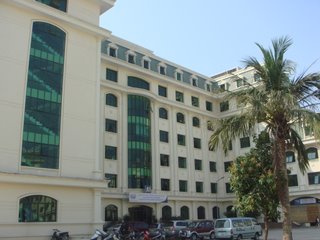
And surely, neither Parisians nor Muscovites would ever tolerate traffic like this! Phnom Penh was mere child’s play next to the “Hanoi Hustle”. Most intersections have no traffic lights, and even those that do are hardly ever effected by them. Interlace your fingers in front of you, and you will see how it works: did your index fingers collide…? Nor do the dozens of scooters, bicycles, cyclos (bicycle powered rickshaws), tour buses, trucks, and every other conveyance known to human kind. They simply avoid each other, merrily tooting their horns to say, “Here I am…”, and push right through. Frankly, it’s terrifying for the first few minutes, but suddenly it’s OK because they seem fine with it, and you’re just another Bozo on the bus (with white knuckles).
We arrive in a pretty beat-up part of town, and suddenly turn off into a dingy alley with barbed wired topped walls covered with odd graffiti. Gulp. But this leads us, after a few more incredibly tight turns, into a large unfinished inner courtyard between two magnificent opposing 7-story buildings. The open windows tell us that we have arrived, for the musicians immediately recognize that sound: dozens of practice rooms going full tilt, with each occupant tooting, scraping or banging away in complete oblivion to their neighbors.
The Official meet & greet is quite formal; every one is given a seat around a large rectangular meeting table, each spot supplied with a chilled unopened water bottle, with the Music Director in the middle of one side opposite Southwest’s Music Director. We are given a brief history of the Conservatory (it has a large Ethnomusicology Dept, and Jazz, too!), and with great enthusiasm for the projects at hand, our residency begins. Immediately.
Within minutes, we are taken to a large rehearsal room and the first collaboration gets under way, the initial rehearsal of Ravel’s sumptuous Mallarmé Songs with both American and Vietnamese players. An hour’s hard work yield’s some great music, and even greater appetites, the latter being satisfied by the Conservatory’s ample buffet created for just this occasion. Social bonds are now built upon the musical, preluding a vigorous afternoon that includes our first rehearsal of a charming Suite by the Conservatory’s composer-in-residence Phuc Linh, and finishing with a truly egalitarian effort, Mendelssohn’s youthful Octet. Youthful because he was only 16 when he wrote it, but also requiring the energy and stamina of the young (at heart or bow), as it is chock full of challenging music at every turn. It takes two string quartets to play this music, and predictably, one was from Pasadena, and one from Hanoi: meaning that there were two first violins (1 American + 1 Vietnamese), two second violins (you get the picture), resulting in a true integration of forces. As Daniel Barenboim has proved time and time again with his Israeli/Palestinian Orchestra, when current or former foes play music together, everyone wins.
Lisa’s Eric, who has been shooting a videolog of the tour, meets us in the lobby upon our well earned return, only to report that that guy seems to have shown up again. Yes, not only has Bill Clinton come to Hanoi, but he’s even staying in our hotel! (Fer Crissake, can’t he just buy a ticket like anyone else?). Eric tailed him for while on the street (gathering evidence for a harassment suit, no doubt), witnessing the world’s most famous smile jump out of his traffic immobilized car and start working the crowd. Some politicians are just born that way
Our bear-infested lobby was filled with live music once again, but not the Smooth Jazz of the previous evening. Two of the Conservatory players from the very Mendelssohn Octet were cheerfully string quarteting Xmas carols, dressed to the nines in concert blacks. The sad thing is that this is the only time these four ever play together as a quartet, Christmas, or some similar social occasion. As we all know, the best way to learn the repertoire for this, the most intimate and seminal of Western chamber ensembles (where would we be without the Beethoven quartets? Or the Mozart? Or Haydn? Or Bartok? Or Carter? Ok, maybe not Carter…) is to form a stable group that plays the classics constantly until they breathe as one. Perhaps the Hanoi Conservatory hasn’t arrived at that point yet, but maybe after another year of two of Southwesting, things might change.
Off to the Old Quarter for dinner, perhaps a little more shopping, and the legendary Hanoi Water Puppets. At Jan’s recommendation [via the NY Times], we left the sordid sidewalks of swirling commercialism to enter the calm courtyard of “The Green Tangerine” for a meal that was gourmet by any standard except price. Candied duck leg with grapefruit & dandelion, rabbit with puree of carrot (what’s up doc?) infused with indigenous herbs, New Zealand ribeye escorted by a miniature fleet of two potato junkers [stuffed potato skins with masts & square sails in the exact shape of the old Chinese junk vessels], and desserts too rich for even the chocoholics to finish, to the benefit of the rest of us. We were guided there by Hai Van (the Conservatory's international relations person), as this neighborhood is incredibly complex and it is very easy to lose one’s way. But half the gang finished early, and Lynn said she knew exactly how to get back to the main street which housed the Puppet show where we were due in 15 minutes, so off we went, in increasingly pulse quickening circles as the countdown began. A few about faces, some map-directed circumnavigation, and we luckily found ourselves behind Hai Van’s group once again, and simply fell in line, none the worse for wear. Yes, we made it on time.
And I wouldn’t missed it for the world, now that I’ve been, but I had grave doubts as we battled past a half dozen gargantuan idling tour buses and line upon line of tourists. Oh boy – another ‘hula’ show where traditions have been diluted beyond recognition? Not in the least. This art form is unique to the Red River Delta, and has been practiced for centuries in the flooded rice fields. Immensely entertaining wooden puppets [animals, humans, mythical beasts] are manipulated via long bamboo poles that run underneath the water, the practitioners hidden by dark bamboo screens. With incredible choreography, these characters danced, swam, flew & promenaded portraying 17 scenes with such titles as “Dragon Dance”,”Rearing Ducks & catching Foxes” & “Harvest Festival – Triumphant return of a new college graduate to his native village, expressing his gratitude to the ancestors” (Dustin Hoffman need not apply). The puppets and their folk tales were certainly mesmerizing, but for us, it was the musicians that had our practically undivided attention.
Seated on a platform above and to the left of the green glowing water out of which smoke-breathing dragons and dancing firecrackers emerged, the ‘pit’ band was dressed in traditional clothing, playing hammered dulcimer, 2-string fiddle, Dan Bao (electric monochord), moon guitars & lutes, and a dizzying array of metal and wooden percussion instruments with electrifying accuracy & drama. Between cues, they looked just as bored as any Broadway pit band playing their 2,483rd performance of Cats, but as soon as they picked up their instruments, the music absolutely rocked! Our bass player Tom Peters & I were so inspired, we went out the very next day and each bought a Dan Bao, and I actually managed to survive a one-hour lesson from a young Conservatory student with just two words of English: a slightly encouraging “Yes”, and a highly disapproving “No!”. The rest was all mimicry on my part, in that oldest form of tutelage, Monkey See, Monkey Do.
Thursday, December 7
And now the next level of the Cultural Exchange, where the American professionals give masterclasses to the Vietnamese students. This experience is a quantum leap above the masterclasses in Cambodia of the previous week, as many of the professorial staff at the internationally recognized Hanoi Conservatory have trained in Europe, Russia & Japan. But these masterclasses will be more about repertoire & interpretation, not basic instrumental techniques.
What becomes immediately apparent is that most students are playing from Xeroxes and not the original music. Scores from the large European music publishers are prohibitively expensive, so that is to be expected: but sometimes the editions are obscure (unknown editors presenting all sorts of eccentric markings as gospel when they never existed in the original), or in the case of one brave oboist who was actually attempting the Berio Sequenza, entire lines of music were missing.
Many of us found wonderful technique and intention, but no clue as to what to do with the notes, which has to do with that most illusory of qualities, musical style. Many of the students that I taught were playing the notes, but not the music – which may sound arcane, but is anything but. The young Vietnamese singers exemplified this problem best: they sang the words from operatic arias, but literally had no idea what the words meant, or what the story was, or who their character was supposed to be, let alone the dramatic impetus at that moment in the plot. These are the subtle ingredients that can transform a mediocre performance into a great musical experience.
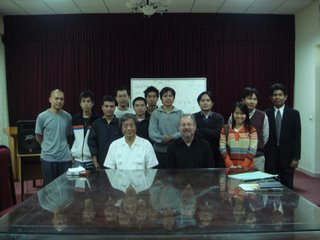
But it wasn’t just the instrumentalists who were holding forth: our composer-in-residence Chinary Ung gave a class on some of his music, and those in attendance found it absolutely riveting, so much so that they weren’t able to tear themselves away to visit any of the other classes. When lunchtime came, some students were so enchanted by their American tutors that they swept them away to lunch. Jim Foschia reported that his masterclass, and subsequent lunch, was one of the best days of his life as a teacher, so profoundly moving had been his interactions. Email addresses were exchanged, and I’m sure that the internet will be buzzing for years to come with conversations started today.
After lunch, a full afternoon rehearsals for the following evening’s historic concert, then back to the Old Quarter after dinner for a little more souvenir-ing. Shopping in a new town is always a hopeful gamble, and one hopes to stumble across some treasure that you simply couldn’t return home without, and it looks like Lynn, Elissa & Kathleen really hit the jackpot. It’s not that they necessarily intended to ‘shop til you’re cyclo driver drops’, but they managed to break the bank at one tiny hole-in-the-wall shop (most are) run by the nicest lady. One thing led to another, “Look at these…!”, and before you knew it, they actually closed the place down. It was a holiday feeding frenzy – after all, why shop at home at thrice the price?
The Old Quarter shopping area has self-segregated according to merchandise. Hence, the ‘toy’ street runs into the ‘food’ street, which parallels the ‘shoe’ street, etc. After a bit of directed wandering, Jan, Tom & I finally found the ‘silk’ street and one elegant shop where (can’t seem to shake them Clintons) the distinguished Senator from New York has her suits made, as evidenced by several prominent portraits of Hillary modeling her purchases, flanked by two positively beaming proprietresses.
Since we left the Old Quarter a few pounds heavier than when we arrived, we decided to engage the services of a cyclo to transport us back to the hotel. These clever contraptions are bicycle driven rickshaws, but wishing to give the customer the best view, they are pushed and not pulled; meaning, like a cowcatcher on the front of the old fashioned steam trains, we’re out front, facing the traffic. A lovely concept, except when entering an intersection where six streets converge into one central crossing era, and the driver is playing ‘chicken’ with about 50 sets of beeping headlights that are coming straight at YOU. Having survived that little scuffle, our driver then sought refuge by merging onto the main highway, with lorries, taxis and autos barreling past at highway speeds, and spewing us with non-stop fumes. When we were finally dumped at the feet of the almighty Hilton (the driver ‘helps’ his customers out of their seats by summarily lifting the back of the vehicle, literally pouring us onto the sidewalk), he asked for a fee that was easily 20 times higher than the usual, pointing to his stomach as he pleaded. He eventually pedaled away smiling, not unpleased with our monetary compromise, as we stumbled back into lobby, an oasis of calm & order after our near calamitous version of Mr. Toad’s Wild Ride.
Friday, December 8
Our poor scribe succumbed to the stomach ailment making its way around the ensemble, so please forgive the straightforward descriptions in order to keep the blog complete.
Dress rehearsal took up our morning at the beautiful concert hall at the Conservatory in preparation for the evening's performance. Jeff built a special program for this historic performance. Beginning with our hometown John Cage, pianist Ming Tsu set the mood with this very atmospheric work by everyone's misunderstood composer. Lou Harrison, our original California world music expert, was represented by his Songs in a Forest. To represent France's influence in Vietnam, Maurice Ravel's Three Mallarme Songs were beautifully sung by Elissa Johnston. Completing the first half of the concert was Chinary Ung's Oracle, providing insight into another work by our resident composer.
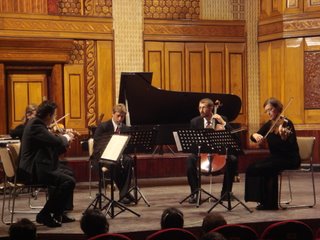
The second half of the concert began with a performance of a work by well-known Vietnamese composer, Phuc Linh, performed by Southwest's musicians. (At a reading earlier in the week, Mr. Linh's obvious enjoyment of having a work performed by Americans endeared him to all of us, and there are plans to take his music to Southwest's American audiences). And then, the soundtrack of the Vietnam War (or American War, as it is known here), Barber's Adagio, played in the string quartet version. It was the highlight of a very emotional evening, and some of our travelers admitted that there were many tears in the audience at the performance, both Vietnamese and American. The fitting finale, musical perfection, came with a gorgeous performance of Mozart's Clarinet Quintet.
Before the concert, Jeff spoke eloquently about the reasons behind the musical selections, and his joy at Southwest Chamber Music's performances in Vietnam. His remarks were translated by Hai Van, the Conservatory's beautiful and helpful International Relations staff person. Backstage, the musicians felt deeply the significance of the concert, and enjoyed seeing again the students who they had taught the previous day.
Flowers, and more flowers! After each work, flowers were given to each member of the ensemble. In the tiny Green Room backstage, they were piled everywhere, roses, carnations, lilies, daffodils, beautifully framed in tissue, each a small masterpiece. In the back of the lobby, the flowers were lined up on a bench around the concert hall, waiting to be brought onstage. None of the musicians could recall a concert with this many flowers, all gorgeous and very appreciated.
After the concert, the musicians and donors were treated to a lavish buffet on the lower level, prepared by the school's librarian. Presents from the Conservatory were distributed to everyone - scarves, purses, ties, books and CDs of the faculty. Many of the musicians felt it was an evening of a lifetime, worth a trip halfway around the globe.
Saturday-Sunday, December 8-9
Up early on Saturday morning, we set out for an overnight excursion to Ha Long Bay, a UNESCO World Cultural Heritage Site. This bay that is part of the Gulf of Tonkin is renowned as one of the most beautiful and unique places in the world. Thousands of limestone mountains and islands jut out of the placid bay. We will join the donors on a three hour bus trip to the bay, then an overnight on a restored paddleboat, the Emmeraude.
On the way we go through the countryside and numerous villages, stopping at a crafts village.
Here the disabled and handicapped children (often from Agent Orange) are taught to do various crafts, such as lacquer ware, silk paintings, embroidery, or jewelry. It becomes compelling to buy something to support the children despite the inflated prices.
Arriving at the Bay, we proceed on board to get our cabin assignments and hear about the activities on the boat. It begins to hit us that we actually have two days off and will basically be in one place - no rehearsals, no teaching, no touring. Just cruisin' around the Bay, looking at the beautiful islands, eating great food, socializing and relaxing. The cabins are adorable, small and stylish, and there is a viewing platform on the top deck. The food features local crab and shrimp, plus a great array of Vietnamese dishes.
Some of us decide to take an excursion to see one of the caves inside the mountains, and we are surprised at the size and beauty of this "hole in the mountain." Before dinner, we learn to make Vietnamese spring rolls, and the following morning some get up early for a Tai Chi class. Most of us would have happily stayed on board for another day, but we have to disembark at 9:30 a.m. on Sunday so they can prepare for the next group.
After returning to Hanoi in the early afternoon, many shop or sleep, and we rendevouz again for dinner at the famous Cha Ca La Vong, an old restaurant that serves only one dish, that of Red River carp, cooked at your table in old clay pots over charcoal. We have two long tables, and beer bottles slowly accumulate. One person asks for white wine, and a bottle of vodka appears instead (and it was delicious). Larry offers a toast with a thank you from the entire ensemble to Jan and Jeff for having the vision to make this trip a reality.
Some bus back to the hotel, and others decide to take one last wander through Old Hanoi's shopping streets. The shops are still open, and there are presents still waiting to be bought.
Monday, December 11
At 9 am, our Vietnamerican string octet is finally on stage of the charming 1911 French style ‘wedding cake’ opera house, giving the Mendelssohn it’s final polishing before the evening’s first public performance. Quite a sound in this visually resplendent gilt white & red velvet 500 seat venue, where every note can be heard with great clarity and warmth. The final run-through of Aura also went well, but with a few bumpy patches.
Though the work had been performed twice before on this tour, neither the loudly air-conditioned Phnom Penh venue nor the carnival-like Expo stage had really given the group the chance to present Aura in it’s best light, and clearly this was the time and the place. Some last minute changes were suggested by the composer (different voice dynamics, since this was a hall built for voices, and the addition of tuned water-filled crystal glasses originally called for in the score) along with various interpretational adjustments…business as usual for a new hall, and a maturing performance of a commissioned work. The temperature of the discussion grew as, among other things, the delicate issue of the players ‘saving themselves for the performance’ hampered the full realization of some ideas, and a few toes were gently trampled. But happily, the necessary friction produced more light than heat, as evidenced by the transcendent performance that evening. Also, a final run through of the opening Takemistu for 4 percussionists & 4 narrators fine-tuned that work as well, and it was on to lunch.
Some of the Octet members had already taxied their way across town to “Guan Nem” which specialized in a marvelous crab, shrimp & rice Spring Roll that was served with rice noodles and a special clear, chilled ginger sauce of soup-like consistency. Huge plates of fresh, savory herbs & greens accompanied each plate of steaming precut spring rolls from which we restocked our tiny bowls, such that each customized concoction produced a mélange which balanced the fresh & the fried, the green & the white, the hot & the cold. And unlike the previous night’s infamous fish house adventure, there was enough remaining for several players to leave with ‘doggy bags’, though that term is probably wildly inappropriate here, considering Peter’s revelation at lunch of witnessing some Cambodian canine grooming that was clearly gastronomic and not cosmetic in intent. Enough said.
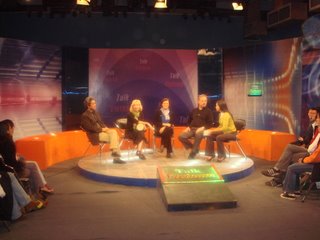
Jeff & Jan ventured in to the city for a very successful TV interview to be seen world-wide by the stations that service the international Vietnamese Diaspora, while others spent their last day finishing shopping lists, practicing, or resting up for the big finale. I used the time to finally spend an hour interviewing our constant traveling companion Dr. Him Sophy, whose beaming countenance has illuminated every room that he has entered since we first met him in Phnom Penh two weeks ago. A distinguished composer and teacher at the Royal University of Fine Arts, I learned more of his impending opera premiere in the States later this year, a work that tells the story of a Cambodian displaced by the Khmer Rouge, and his fascinating relationship with a (yes) rock star…looks like a sure hit, too. Like some of Chinary’s recent music, Dr. Sophy will also be mixing traditional Cambodian music with Western styles, but his opera also uses the electric guitars, keyboards and drums of popular music. It also turns out that the good Dr. is the author of an unpublished 500 page book on Cambodian classical music – written in Russian! (He did his graduate work in Moscow.) Remember that name – we’ll be reading about him in the American newspapers soon, I’m sure.
Concert call at 7:30 at the Opera – the percussion stations are all set for Takemitsu’s The Seasons which opens the evening. The Green room is abuzz with players warming up, running those difficult passages one last time, final equipment checks, tie & hem straightenings, all under the watchful gaze of the gigantic golden bust of Ho Chi Minh, whose massive mahogany pedestal has been relegated to a rather forgotten back stage corner. After a few brief formal salutations by the appropriate dignitaries, our last concert in this extraordinary Asian tour begins.
And it is the best night ever – having seen countless temples, towers and other sacred structures crowned with four-faced visages whose gazes embrace the four cardinal directions, it is only appropriate to begin this historic evening with Takemitsu’s planetary evocation “The Seasons”. Four percussionists are stationed across from one another on stage, each armed with a bewildering battery of noisemakers made of glass, metal, wood & stone (and a little plastic, too), creating undulating waves of sound ranging from the whisperingly quiescent to the tempestuous. The piece, which aspires toward world unity, was commissioned by the Osaka World’s Fair, and also includes four speakers (one per percussion station) who recite the Weather Report from four different parts of the world, in the appropriate language. Lynn Vartan led three Hanoi Conservatory percussionists, whilst I reported on American weather in AmerEnglish, Dr. Sophy was our Russian climatologist, and two speakers from the Conservatory reported in Vietnamese & German. The audience was complete enraptured.
There are very few chamber music groups that would dare to follow the hypermodernism of Takemitsu with the High Romanticism of the European 19th century, but then again, Southwest is renowned for their curatorial derring-do. Dare they did, and to great effect. To hear Mendelssohn’s passionate and difficult Octet performed at all is a treat, but to see it mastered by pairs of American and Vietnamese musicians added yet another layer of appreciation to a work which epitomizes the Western traditions of Classical Music. It has been said that one should either spend six months agonizing over every phrase, every bowing and every dynamic of this masterwork, or put it together in a day’s worth of rehearsals and let the work generate it’s own internal magic. That night, I believe that the audience was treated to the best of both worlds, though the musicians only had that week to prepare it (and a host of other offerings); the coherence with which hands, hearts and strings joined was nothing short of inspirational.
As has happened so often during this tour, the juxtaposition of the Asian, the European and the American was the exquisite spice that uniquely enhanced every musical offering. To experience a German Romantic composer performed by American & Vietnamese musicians in a French opera house built by Asian hands was the essence of this historic cultural exchange which illustrated the myriad economic, political and artistic complexities of the past. While those cultural cross references were perhaps only apparent between the ears of the beholders, the work that filled the second half clearly pointed towards the future by integrating elements both Eastern & Western, Ancient & Modern, even the Sacred & the Profane.
It turns out that Aura really is an opera, and it took a 500 seat wedding cake Parisian opera house in Hanoi (oh yes, and two years of preparation, recording and all of those other performances) to make this the most transcendent performance ever. The two solo voices took on a completely different relationship with the evocative chanted commentaries of the orchestra…the wine glasses exuded their unearthly emanations…the intimate acoustics allowed performers and audience alike to luxuriate over details that were too often masked (or swallowed by external circumstances) before, but in reality, there was really no explaining it. Why does Magic happen? Not just because the performers knew the work inside out, and were either exhausted or exhilarated into inspiration…or a Last Blast of Adrenaline knowing that this group wouldn’t be playing the piece again for a long time, hence giving it their ‘all’.
Or was it because, after two weeks of tasting the food, breathing the air, and sensing the history, all concerned were much closer to the elements which had inspired the composer, and this additional Asian perspective may have subconsciously inspired a truly enchanted performance. Chinary has told us that in the Cambodian tradition, musicians & dancers perform long meditations before imparting the cultural truths with which they have been entrusted, such that they will become the appropriate conduits for their respective art forms. Perhaps the past two weeks have been Southwest Chamber Music’s own Asian meditation, and in the telling of Chinary’s tale of the Buddha’s Enlightenment, we all left the 1911 Hanoi Opera House, and returned home the next morning, with our feet a little bit higher off the ground.
